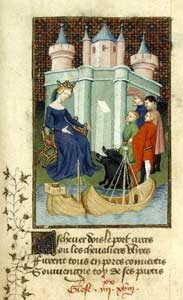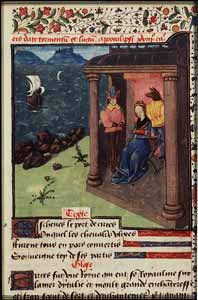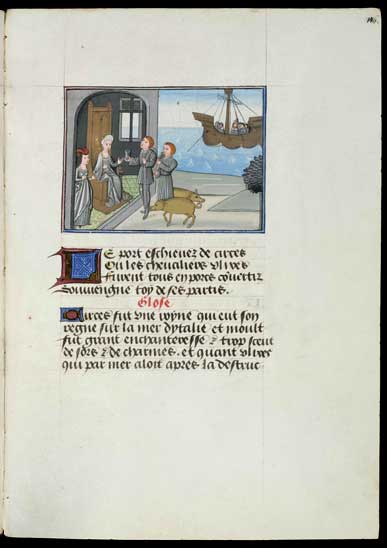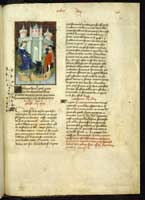15th century

-
Circe
- from: ‘The Epistle of Othea’
(Harley 4431; f. 140) - (c. 1410-c. 1414), illumination in gold and colours on parchment
- 14.4 x 11.3 in. (36.5 x 28.5 cm.) full page dimensions in 2 columns
- The British Library
-
Editor’s Note:
This is an illumination of the sorceress Circe changing Ulysses’ companions into swine. It is from a copy of Christine de Pizan’s ‘The Epistle of Othea’ created in France about 1410-1414. It is attributed to the anonymous French illustrator known as the Master of the Cité des Dames (fl. 1400-1415) and is now housed in The British Library.
The Master of the Cité des Dames, (fl. in Paris, c. 1405-1415), also Cité des dames Master or Master of the City of Ladies. He was a French illuminator who is defined and recognized by the exquisite work done by him and his workshop on several copies of Christine de Pisan’s Cité des Dames.
Here is a view of the full page of Circe:

-
Circe
- from: ‘The Epistle of Othea’
(KB, 74 G 27; fol. 93r) - (ca. 1450-1475), illumination in gold and colours on vellum
- 3.7 x 3.5 in. (9.5 x 9 cm.) image only
- Koninklijke Bibliotheek, The Hague
-
Editor’s Note:
This is an illumination of the sorceress Circe and two of Ulysses’ companions, one of whom has been turned into a swine. It is by an anonymous French illustrator and comes from a copy of Christine de Pizan’s ‘The Epistle of Othea’ created in France about 1450-1475 and now in the Koninklijke Bibliotheekin, The Hague, Netherlands.

-
Circe
- from: ‘The Epistle of Othea’
(Cologny, Fondation Martin Bodmer, Cod. Bodmer 49, Ff. 146r) - (c. 1460), illumination in gold and colours on parchment
- 11.02 x 7.87 in. (28.0 x 20.0 cm) full page dimensions
- Bodmer Foundation in Cologny, Switzerland
-
Editor’s Note:
This manuscript was executed for Antoine, Grand Bastard of Burgundy (1421-1504) of the House of Valois-Burgundy. The illustrator is believed to be a contemporary of Loyset Liédet [or Lyedet] (1420-1479), an early Netherlandish miniaturist and illuminator, and was influenced by him.
About the Artist
Epistre d’Othéa (ca. 1400-01) (also ‘L’Épître Othéa’ or ‘Epistre d’Othéa a Hector’) was the first long work of Christine de Pisan. It is a work of moral instruction, in verse and prose, in the form of an allegorical story describing the moral and spiritual education of a young knight, Hector. Epistre d’Othéa takes the form of a letter written by Othea (a goddess who symbolizes wisdom and prudence) to the Trojan hero Hector. The letter is divided up into 100 chapters, each consisting of a miniature illustration and a verse text recounting a story from classical mythology, a prose explanation designed to expound the moral significance of the story, and finally a prose allegory expounding its underlying spiritual/Christian interpretation. [DES-01/11]
Christine de Pisan (also seen as de Pizan) (1363–ca. 1430) was a Venetian born French woman poet and author of the medieval era who strongly challenged misogyny and stereotypes prevalent in the male-dominated realm of the arts. As a poet, she was well known and highly regarded in her own day. [DES-04/11]
Additional information:
- Charity Cannon Willard, United States (1914-2005) was a biographer of early French feminist and author Christine de Pizan (1363-1440).
- Christine de Pizan: Her Life and Works by Charity Cannon Willard (1984)
- Charity Cannon Willard at GoodReads.com
- Christine de Pizan’s The Book of Deeds of Arms and of Chivalry by Christine de Pizan and translated and edited by Sumner and Charity Cannon Willard.

